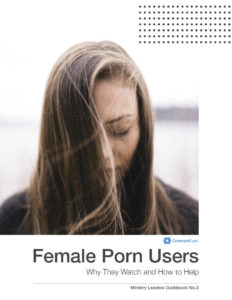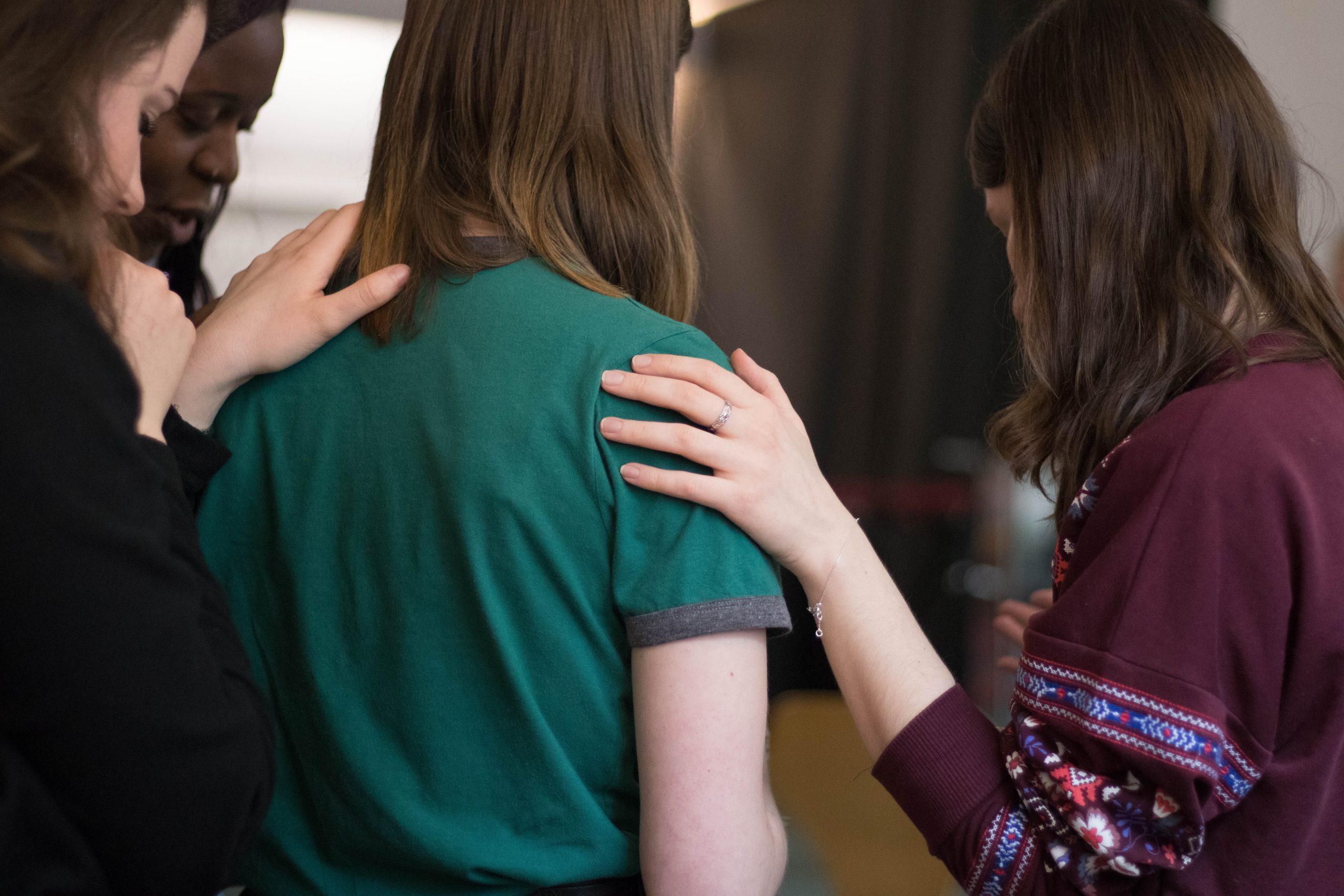We’re kicking off our Porn in Church series with a guest post from my friend, Sam Black.
He’s sharing a bit of his heart on what pastors need to know about women and pornography. In the weeks to come, posts will address more practical nuts and bolts of how to address this issue in churches and help women find healing.
Please, share this series with your pastors!
Editor’s note: Sam Black, a vice president at Covenant Eyes, is writing a book to pastors on how some churches are successfully addressing pornography among Christians. The following is a condensed chapter excerpt. Want to be the first to hear about the book’s release? Send a note to Sam Black at Sam.Black@covenanteyes.com.
Update: Pick up Sam’s book now!
Without intention Catherine crushes stereotypes with the feminine force of a sledgehammer.
Dressed modestly with no makeup, she appears to have stepped away from a conservative Sunday morning worship service most days of the week. Raised in a Christian home, she attends church faithfully with her husband with whom she shares a deep bond after five years of marriage. She didn’t date in her teen years, and she wore white proudly on her wedding day, grateful that she saved sex until marriage. She’s slender, cute, and sometimes shy, but she’s also well-spoken, astute, and intuitive.
True to a growing trend among young women struggling with porn, Catherine is not reading erotica as older surveys show, she watches porn videos and masturbates. Very short looping videos, called gifs, that have no storyline and all action is what Catherine says is her personal Achilles heel. Days after watching it, the loop replays in her mind for weeks.
One stereotype that rings true for Catherine, she feels her church should be a place to find help but doubts anyone in her congregation would understand.
“What I hear more than anything else from women is, ‘I thought I was the only one,’” Counselor Marnie Ferree said during an interview at Bethesda Workshops in Nashville, where she provides clinical intensives for porn and sex addiction.
Though Catherine felt like a unique sinner for many years, one study showed that 73% of women (mainly between the ages of 18 and 35) used porn in the last six months and 26% in the last week. In an online survey of young women 18 to 29, 14% said they watched porn a few times per week and 18% watched porn about once per week, and 20% of all the women surveyed said they worried that they watched too much porn.
While church leaders watched these statistics grow in recent decades, they have difficulty connecting them to the diverse and caring girls and women under their care. As a church leader, you may have a hard time accepting that girls and women in your church struggle with porn, and that’s understandable. First, the majority of Christian women don’t struggle with porn like the majority of Christian men do. Second, growing up and in your adult life you likely heard women speaking negatively about our sexualized culture…and for good reason.
Third, the Church has often given women a great deal of responsibility to shoulder in regard to sexuality. Women are to dress modestly so as to not provoke a man to lust, and this can be especially true within specific denominations or sects of Christianity. Wives are to be sexually available to prevent their husbands from lusting. Girls and women have to be careful in so many ways to guard men, Ferree said, and many leaders in the church give shallow consideration to women as sexual beings. Stereotypes, she said, have often viewed women as either the seductress or a reluctant participant.
“That women themselves could be struggling with love, sex, relationships, and pornography addiction many times never crosses the radar,” Ferree said. “It does not occur to people within our church culture, and when it does there is an added stigma, disbelief, shame, and judgement associated with women who struggle.”
Men and women have more in common than you might think when it comes to porn struggles. Early childhood exposure, repetitive and ongoing use of porn, dysfunctional homes in childhood, and trauma can contribute to compulsive and unwanted sexual behaviors, including compulsive porn use.
Early Exposure
When Catherine’s parents brought the Internet home in 2002, they would never have guessed that she would intentionally seek online pornography at 11 years old. (Eleven is the average age for girls to be exposed to porn, Jay Stringer writes in Unwanted.) Her fifth-grade friends whispered about sex, and with her new online access she had questions and deep curiosity. Her home computer had no filters or monitoring software, and she quickly learned how to cover the tracks of her growing online habit.
Catherine found that the images and videos she saw stuck in her memory, and she could replay them at will, and sometimes they played against her will. Like most females, Catherine naturally excels at recalling imagery, objects, and everyday events, more so than males. To avoid getting caught seeking porn on the family computer, she would simply replay porn from her own memory library. Especially when she felt stress and anxiety, the videos would loop through her mind and it served as an escape. As a teen and as an adult, she knew what she was doing didn’t match her Christian convictions, but she couldn’t seem to stop.
Unlike past generations, today’s young women grew up with mobile access to the Internet. The first iPhone was released in 2007; the first iPad in 2010. Women younger than 30 likely would have received their first (unmonitored) mobile device before they left home, and even if a girl didn’t have a device of her own, her friends surely did.
Among many conversations I’ve had in regard to girls seeing porn early, I spoke to a family at Christian homeschool conference in Arkansas, where a 15-year-old girl brought her parents to the Covenant Eyes booth. Well-spoken and fashionably dressed, she explained that at age 8 she overheard boys using words she didn’t understand, so she used her dad’s phone to look them up. That was her first exposure to porn. Assured of her innocence, her parents would hand over their phones when she asked. She continually sought porn for two years before her parents discovered her activity.
As a whole, women were most likely introduced to porn through their relationships, be it a peer or an adult. Many of Stringer’s clients reported finding family members’ porn stashes in “hidden,” yet obvious locations like a bathroom or a treehouse. At 10 years old, Christian counselor Crystal Renaud Day found her brother’s porn in his bathroom, “which catapulted me into an 8-year addiction to porn and other sexual behaviors.”
Parental Relationships
While many women were introduced to porn and sexual media relationally, parental relationships are exceptionally important as to whether a girl will struggle in adulthood. Women are 56% less likely to struggle with significant pornography viewing as an adult when they have fathers who are emotionally and physically present.
For Catherine, her dad was present physically, but emotionally absent. He rarely interacted with his only child, and reticent with his wife except when yelling was involved. Throughout her childhood, Catherine never saw her dad kiss her mom or even hold her hand.
“Growing up, I felt extremely distant from him and I felt like I had to be perfect in order for him to recognize me,” she said. “The few times that we would go out to eat as a family was when I got straight- As. I got to spend time with my dad, if I performed well in school. So, I was very scholastic, always very into my schoolwork.”
Two decades ago, Ferree pulled back the veil of women’s unwanted sexual behaviors in her book No Stones, Women Redeemed from Sexual Addiction. Since then, she has written and edited treatment guides, workbooks, and led thousands of people through intensive workshops.
Ferree said there are multiple ways that a child can feel abandoned by her parents. Physical
abandonment can come in the forms of a parent dying, the strained relationships that come through divorce, a parent being a workaholic. Emotional abandonment can happen simply because a parent lacks the skills to emotionally nurture a child, because the parent never learned these skills in their own childhood.
Sexual Abandonment
Though so common, especially in the church, parents often don’t consider the impact of saying little or nothing about sex. One woman told me her dad asked her as a teen if she knew what sex was. When she replied that she did, he said, “Good. Don’t do it.” That was her only discussion of sex with her parents.
Sexual abandonment occurs when parents ignore their responsibility to provide their children
instruction about the design of their bodies. Catherine married without a single conversation with her parents about sex, everything she knew came from her peers and porn. And porn wasn’t sex, right? So, she was doing the “Christian thing” in not dating, not having sex, and preserving her virginity until marriage.
In her book, Beggar’s Daughter, Jessica Harris said that while the purity movement of the 1990s and early 2000s provided guidance about saving sex until marriage, it missed any meaningful understanding about sex.
“As a young woman, I wasn’t supposed to ask about it, talk about it, think about it, or dress in a way that made men think about it. [She continues] Pornography was not sex. In fact, pornography seemed like a perfectly acceptable alternative to sex. I could explore and indulge while keeping my virginity intact and avoid all the nasty STDs and the whole potential pregnancy problem. It made perfect sense.” (pg.50-51, Beggar’s Daughter)
While generations of women entered their sexual lives with poor information, porn and sex addicts are just as ignorant, Ferree writes in No Stones, pg. 136. “In my experience, female sex addicts are woefully ignorant. In terms of factual concrete knowledge about anatomy, how the body works and normal sexual response, they often know very little. They may have loads of sexual experiences, but they know little that’s accurate about the subject.”
Research shows that when children grow up with good information about sex, they have less need to experiment, have a safe place to discuss their temptations, and make safer choices. When good instruction is lacking, they turn to an overly sexualized culture that makes kids more susceptible to abuse and exploitation, Ferree said.
Sexual abuse
Childhood sexual abuse is one of the strongest drivers of unwanted sexual behavior in adulthood for both men and women. A 2014 study found 26.6% of girls had experienced sexual abuse by the age of 17.
Gender and the age of the onset of childhood sexual abuse are the two biggest factors in whether
someone becomes sexually inhibited on one side of the spectrum or sexually compulsive on the other side, the study showed. Women whose sexual abuse began after age 12 are more likely to become inhibited and fearful of sex. When girls experience sexual abuse before the age of 12, they are more likely to develop compulsive sexual behaviors.
Putting it all together
The harms that come to our lives have a cumulative impact on the heart and mind. Research shows that trauma victims attempt to control their inner struggles through any number of means of self-soothing. Sometimes poor but reliable sources of temporary mood management come through shopping, eating, drinking, doing drugs, masturbating to porn, or using sex.
The compulsive porn user and the woman with unwanted sexual behaviors desperately wants to control her actions, but continually fails under her own power, Ferree writes in a L.I.F.E. Recovery Guide for Women. The unresolved issues become an excuse (often subconscious) for continuing in sinful behaviors. Acting out comforts internal distress and might have been fun at first, but overtime the compulsive behavior became burdensome, Ferree writes. In fighting back, women and men may find periods where they stop the behavior only for it to return because they haven’t embarked on the more difficult road of healing and recovery.
“What you need is wholeness,” Ferree proclaims. “Being whole means you are practicing real intimacy. It means you are self-aware and capable of modulating negative emotions through healthy means. It means you are present in the moment instead of being lost in your head. It means you no longer hide behind ‘fine.’
“Being whole means God is having His way with you, and as a result you are being transformed inside and out.”
Jessica’s Note: I highly recommend pastors pick up a copy of Unwanted by Jay Stringer (read my review here). It touches on many of these themes and applies the Gospel to our sexual journeys. I’ll be rounding up more resources to share at the end of this series.






